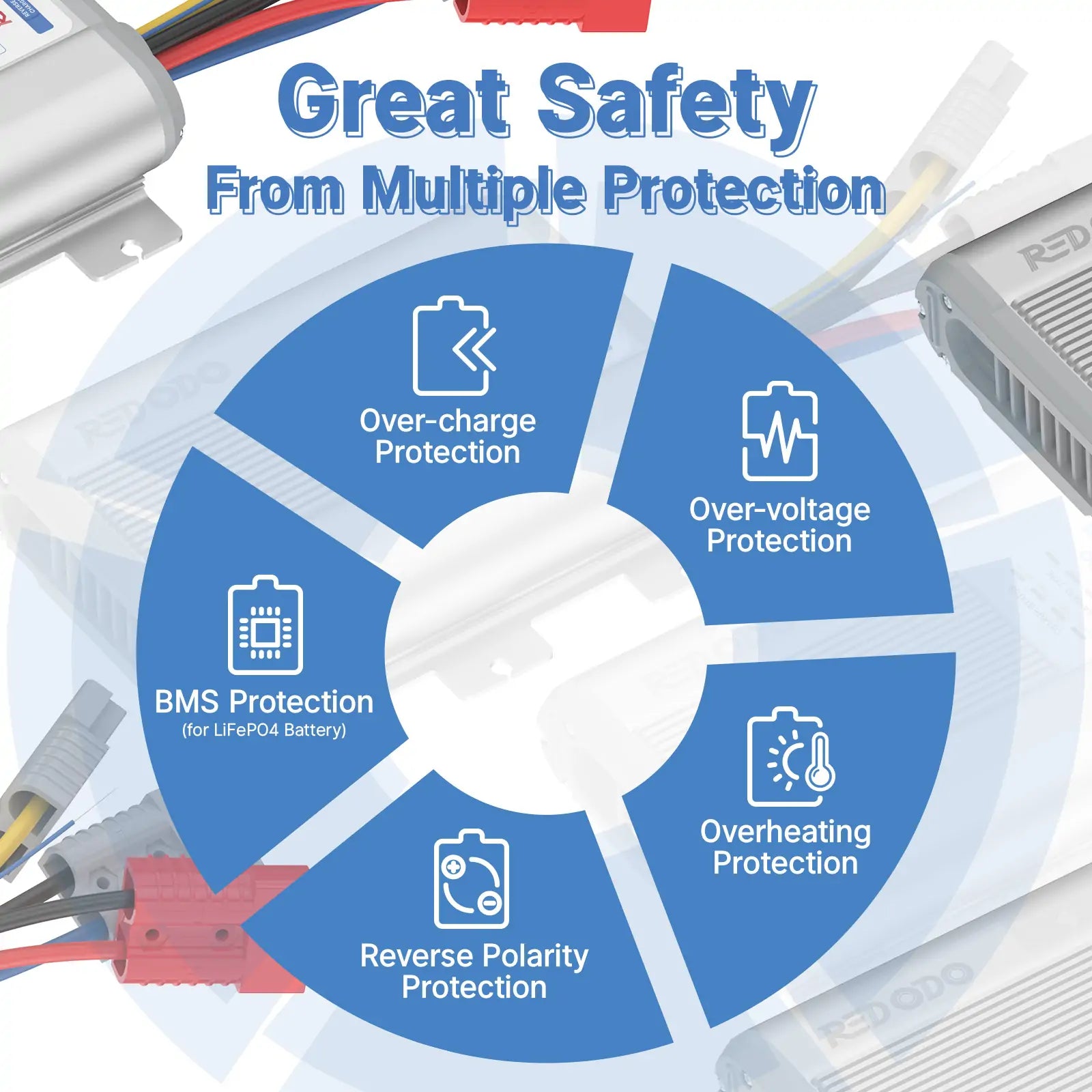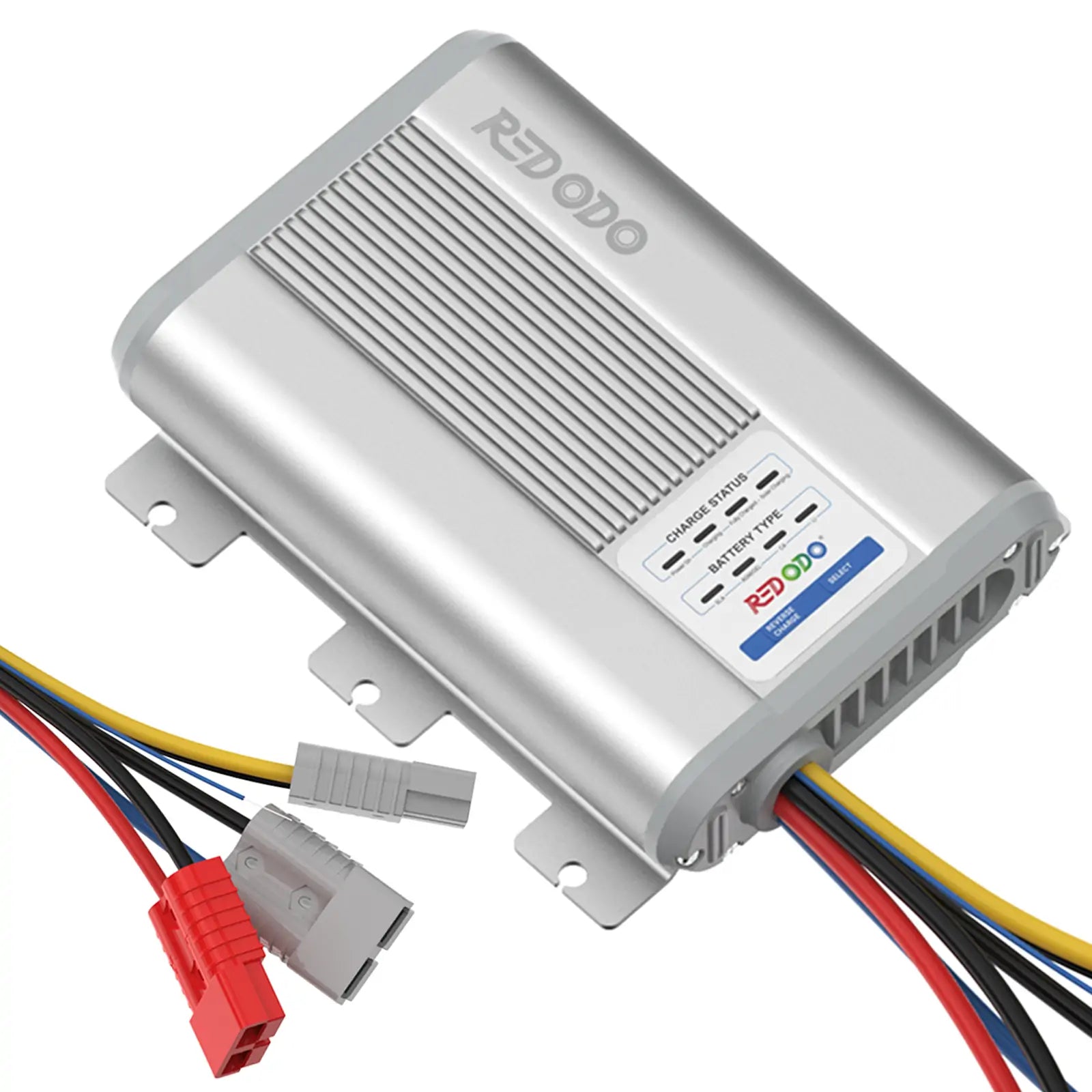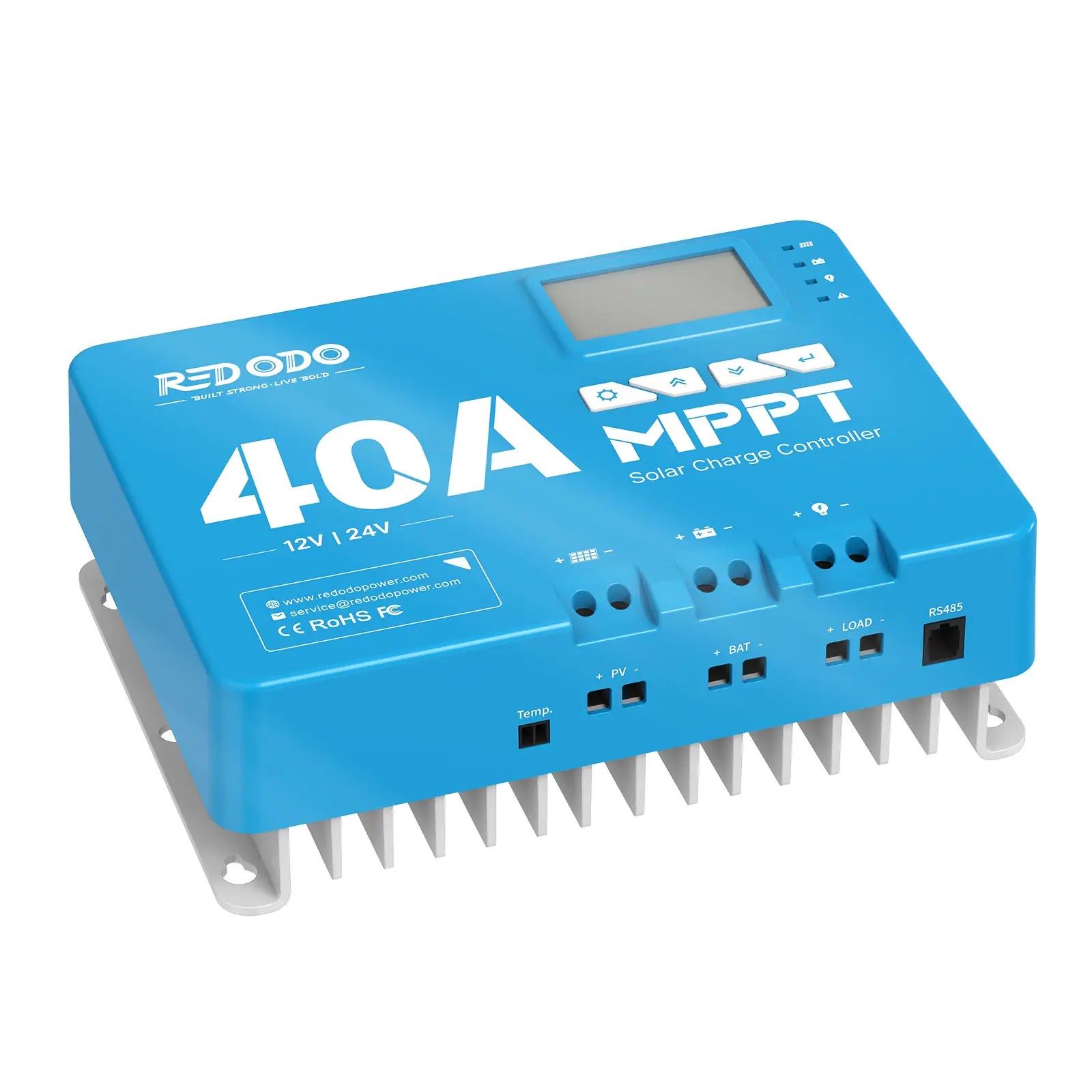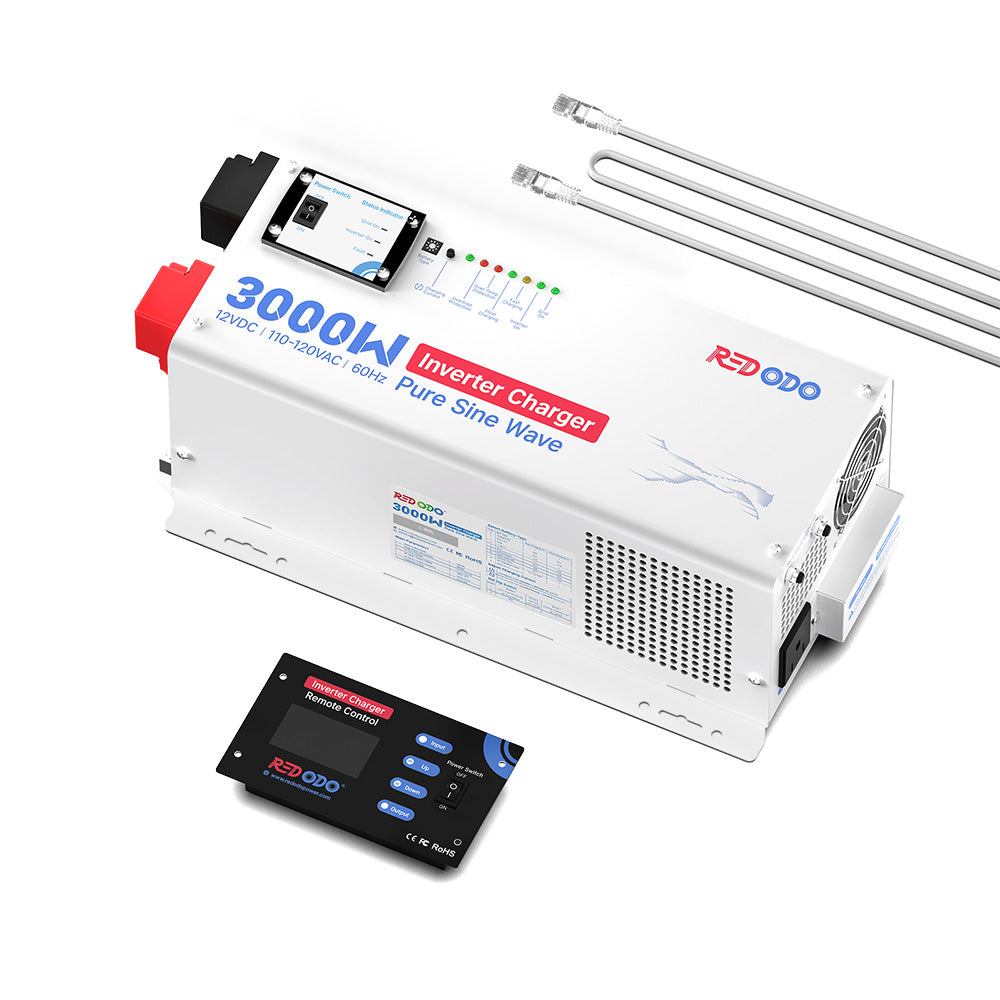[Newest] What Does a DC-DC Battery Charger Do
Would you like to learn more about the advantages of using a DC-DC battery charger for your campervan? Maintaining a steady supply of electricity is crucial for extended journeys, as it powers various essential functions such as lighting, switchboards, sockets, as well as ensuring the proper functioning of appliances like refrigerators, heating systems, and water pumps.
There are multiple methods available for charging campervan batteries, with the primary options being:
- Alternator (DC-DC): This method involves using the vehicle's alternator to charge the batteries in your campervan.
- Solar: Utilizing solar panels to harness the sun's energy and convert it into electricity for charging the batteries.
- Shore Power (Plugging it in): This option requires an inverter/charger, allowing you to connect your campervan to a reliable external power source.
So what does a DC-DC battery charger do? Why do you need it? Let’s dive in to find out.
What is a DC-DC Battery Charger?
Simply put, a DC-DC battery charger is a device that helps you charge the batteries in your campervan using your vehicle's alternator. Normally, the alternator charges the vehicle battery while you drive.
However, when you have a campervan, you also want to charge your house batteries, which power the components inside the campervan like lights. The problem is that the vehicle's alternator doesn't know about the campervan conversion and how much power it needs to put out. This is where the DC-DC battery charger comes in. It acts as a bridge between the alternator and the campervan's batteries, ensuring that the batteries are charged efficiently and safely.
Why Do You Need A DC-DC Charger
A DC-DC battery charger is needed for a campervan to efficiently charge its house batteries using the vehicle's alternator. The vehicle's alternator is designed to charge the vehicle battery, which may not provide the optimal charging voltage for the campervan's house batteries. By using a DC-DC charger, campervan owners can ensure a stable and reliable power supply for their essential functions like lighting, switchboards, sockets, and appliances such as refrigerators and heating systems.
The DC-DC charger allows for the conversion and regulation of the alternator's varying voltage to a constant voltage suitable for charging the campervan's batteries. This ensures that the batteries are charged efficiently and that the power supply is reliable even during long trips or off-grid adventures.
In short, the DC-DC battery charger acts as the "brain" that regulates and controls the charging process for the house batteries in a campervan setup. It communicates with the alternator to determine the type of house battery and its charging requirements. The DC-DC charger then instructs the alternator on how to properly charge the house batteries, ensuring efficient and optimal charging.
What is DC (Direct Current)
Let's delve into the world of DC (direct current) and its applications in more detail. DC, known for its constant voltage flow, is widely used in small vehicles like cars, boats, and vans due to its efficiency. In recent times, with the increasing popularity of solar power in vans, DC and DC-DC battery chargers have become vital components.
So, how do they compare?
A DC-DC charger, also referred to as a battery to battery charger, takes the output from your primary battery and utilizes optimal charging to charge your secondary battery. Typically, a single battery or a battery system is used to store the converted power. The secondary batteries powered by the DC-DC charger can be used for various purposes, such as charging cellphones or running major appliances like a fridge.
Tips: If you're a frequent traveler, constantly on the road in your van, the DC-DC converter allows for efficient charging of your secondary battery.
How Does a DC-DC Battery Charger Work
A DC-DC battery charger works by regulating the charging process between the vehicle's alternator and the house batteries. It ensures efficient and optimal charging by communicating with the alternator to determine the battery type and charging requirements. Here is a step-by-step breakdown of how it works:
- Input voltage sensing: The DC-DC charger measures the input voltage from the vehicle's alternator to determine its level and adjusts the charging process accordingly.
- Charging process: The charger converts the input voltage from the alternator (usually 12V) to the required charging voltage for the house batteries. It ensures that the batteries receive a stable and regulated charging current, preventing overcharging or undercharging.
- Battery type detection: Many DC-DC chargers can automatically detect the battery type (e.g., AGM, gel, lithium) connected to them. This allows them to apply the correct charging algorithm for that specific battery chemistry, optimizing the charging process and extending battery life.
- Remote communication: Some DC-DC chargers can communicate with the vehicle's battery management system or a monitoring device to gather information about the battery's state of charge (SOC) and other status indicators. This enables smarter charging algorithms and more precise control over the charging process.
- Output voltage regulation: The charger ensures a stable output voltage to the house batteries, compensating for any fluctuations in the input voltage or load variations. This provides a consistent power supply for various campervan functions like lighting, switchboards, sockets, and appliances.
- Battery protection features: DC-DC chargers often come with built-in safety features to protect the batteries, such as overcharge protection, short-circuit protection, and reverse polarity protection. These safety mechanisms help prevent damage to the batteries and the charging system.

What is an On-Board DC to DC Charger?
An on-board DC to DC charger is a charger specifically designed for vehicles with multiple batteries, such as RVs or boats. It allows for efficient and regulated charging of auxiliary batteries from the vehicle's main battery or electrical system.
The Redodo 12V on-board DC to DC battery charger is a reliable and convenient solution for permanent installations. It charges your secondary batteries while you drive, using the primary battery connected to the vehicle's alternator. This ensures that your starting battery remains a priority and eliminates any concerns about starting your vehicle. With this charger, your solar power system can now charge your service battery first, allowing you to stay fully charged and off-grid for extended periods.

The Benefits of Using a DC-DC Charger
Here are some benefits of installing a DC-DC charger in a campervan:
Overcoming issues with smart alternators:
Many vans now come with smart alternators that restrict the power output, making it difficult to charge a secondary battery. A DC-DC charger solves this problem by isolating the main battery from the alternator.

Maximizing main battery charge:
A DC-DC charger can efficiently convert an amperage of as low as 9 volts up to 13.5 volts to quickly and effectively charge the main battery. This can help achieve close to 100% charge with a good day of driving.
Independence from solar power:
In areas with limited sunlight, DC-DC chargers provide a reliable solution for charging the auxiliary battery and powering gadgets without relying on solar power or other backup energy sources.
Compatibility with different batteries:
DC-DC chargers are versatile and can adapt to different battery types. This eliminates the need to purchase a new charger every time the battery is replaced, saving time and cost.

DC to DC Charger or Isolator
Both a DC-DC charger and an isolator can be used for charging auxiliary batteries in a campervan. However, there are some differences between the two.
A DC-DC charger is a more advanced and intelligent charging system. It regulates the charging process by communicating with the alternator to determine the battery type and charging requirements. It ensures effective and efficient charging, preventing overcharging and undercharging of the batteries. In addition, DC-DC chargers often have features like multiple charging profiles for different battery types, voltage boost capabilities, and temperature compensation. They also provide a stable and reliable power supply to the campervan's electrical system, enabling it to function optimally.
On the other hand, an isolator is a simpler device that allows current to flow from the alternator to the auxiliary batteries while preventing the batteries from discharging into the main vehicle battery. It essentially isolates the two battery systems, ensuring that the vehicle's main battery remains charged while the auxiliary batteries are being charged.
While an isolator can be a more affordable option, a DC-DC charger offers more control and flexibility in the charging process. It is particularly useful for situations where different battery types or charging requirements are involved, such as lithium batteries or deep-cycle batteries.
Ultimately, the choice between a DC-DC charger and an isolator depends on your specific needs and preferences. If you require more advanced charging capabilities or have specific battery requirements, a DC-DC charger might be the better option.
What Size DC-DC Charger Should You Get
Typically, it is recommended to use a DC-DC battery charger with a capacity of 25Ah for batteries up to 200Ah. For batteries larger than 200Ah, a 40-ampere charger would be more suitable.
To determine the charging power from your alternator, it is advisable to consider half of its rated ampere capacity. Running the alternator at 50% load is recommended to prevent excessive strain and premature wear on the alternator. It is important to prioritize the longevity and efficiency of the alternator when selecting an appropriate charging setup for your batteries.
To calculate the size, follow these steps:
- Determine the capacity of your auxiliary battery in ampere-hours (Ah). This information is usually provided by the battery manufacturer.
- Consider the charging rate of your vehicle's alternator. The alternator's output is specified in amps.
- Calculate the charging current required to charge your battery. As a general guideline, it is recommended to charge the battery at a rate of 10-20% of its capacity. For example, if you have a 100Ah battery, you might want to charge it at a rate of 10-20 amps.
- Choose a DC-DC charger that can deliver the desired charging current.
Keep in mind that it's important to select a DC-DC charger that can safely handle the charging requirements of your system. It's generally better to choose a charger with a slightly higher amperage rating than required to allow for future expansion or higher power demands.
If you're unsure about the specific size, consult the manufacturer's recommendations or seek guidance from a professional in the field.
DC to DC Charger with Solar Input
A DC to DC charger with solar input like Redodo 12V 40A DC-DC charger is a versatile device that enables you to harness the power of solar energy to charge batteries or power devices. It efficiently converts the DC voltage produced by solar panels into a different output voltage level, making it suitable for a variety of applications.

One key component of these chargers is the solar charge controller. This controller regulates and optimizes the charging process by ensuring that the solar panels generate the appropriate voltage and current for efficient battery charging. It also safeguards against overcharging or damaging the battery, extending its lifespan.
Furthermore, many DC to DC chargers with solar input employ multiple charging stages. These stages, such as bulk charging, absorption charging, and float charging, maximize the battery's longevity and maintain its optimal performance. Additionally, some models utilize MPPT (Maximum Power Point Tracking) technology, which enhances the conversion efficiency by identifying the maximum power point of the solar panels and extracting the most energy from them.
By utilizing a DC to DC charger with solar input, you can take advantage of solar power to charge your batteries. This reduces your reliance on the grid and provides a sustainable and renewable energy source for your charging needs. It offers a convenient and eco-friendly solution for powering your devices or maintaining battery levels in various settings.
Conclusion
With a solid understanding of the benefits and features of DC-DC chargers with solar input, you can now make an informed decision to select the ideal charger that meets your specific requirements.
![[Newest] What Does a DC-DC Battery Charger Do](http://www.redodopower.com/cdn/shop/files/20220402-182128_f406e536-af3b-484f-ba7c-2f4771ec4559.png?crop=center&format=webp&height=24&v=1656668006&width=24)
Redodo
![[Newest] What Does a DC-DC Battery Charger Do](http://www.redodopower.com/cdn/shop/files/20220402-182128_f406e536-af3b-484f-ba7c-2f4771ec4559.png?crop=center&format=webp&height=24&v=1656668006&width=24)
Redodo
Join Redodo
Related Post

Light Up Your Christmas with Redodo: LiFePO4 Batteries Holiday Deals

How to Choose the Best Battery for Van Life?

What Size Battery Do I Need for a Travel Trailer?

36V vs. 48V Battery for Golf Cart: Which Is Better?









